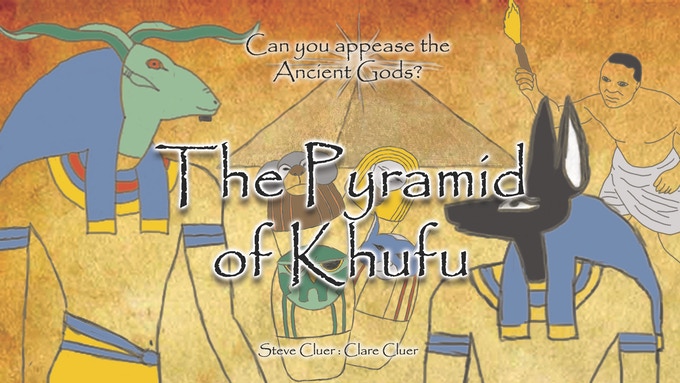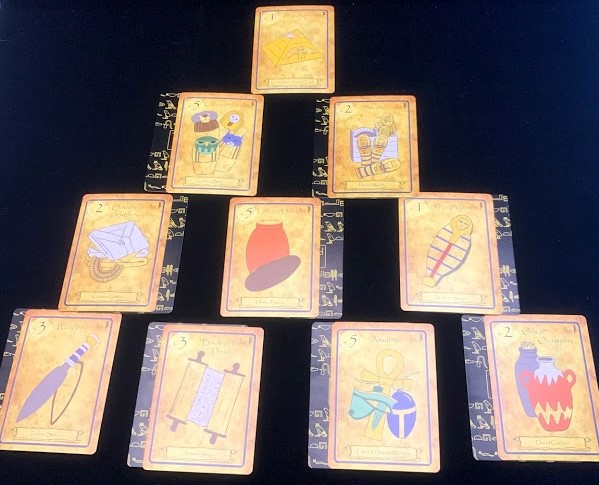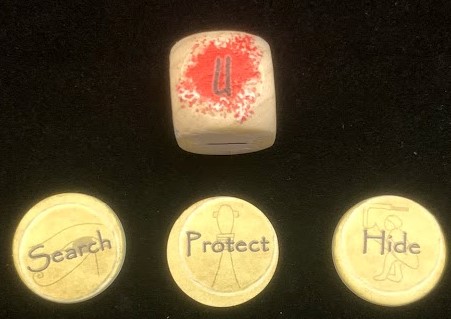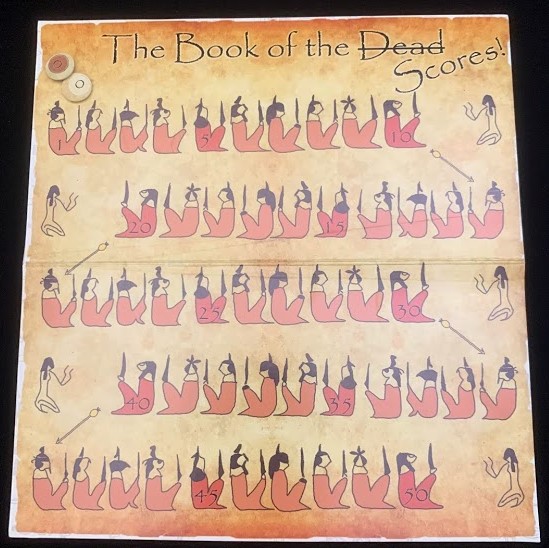Will your mortal body be safeguarded by the Egyptian Gods? Plan accordingly for your afterlife!

| The Pyramid of Khufu (2020) | |||||
| Designer(s) | Steve Cluer | Artist(s) | Clare Cluer | Publisher |
LVC Games |
| 1-2 | 14+ | 30 m | |||
In The Pyramid of Khufu, you take on the roll of Pharaoh Khufu as you prepare your mortal body for the afterlife in your pyramid. In order to achieve this, you must play cards to build your pyramid up in 4 levels: subterranean level, Queen's Chamber, King's Chamber and the Capstone. You do this by laying sacred items and getting them blessed by up to 2 different Egyptian Gods. The first person that can build out all 9 sacred items over the main 3 levels of your pyramid and applying the capstone triggers the end game. However, just because you ended the game doesn't mean you win. Your score is based on the points from each of your sacred items as well as points applied from your Gods. Some Gods will give you positive points, but others may not like who else is in your pyramid so they will apply negative points to your score. Whomever has the most points wins the game and will have a blessed afterlife.
Box and Components
The box is made of a very sturdy material. The artwork on the box pulls the theme of the game into it. Another nice thing with this game, there is no plastic materials in this game; even the die is wooden. This is also indicated on the box with a little green recycle symbol. The cards were grouped together with a paper band, the markers are made of cardboard. The box also has a cardboard divider that separates the cards into 2 stacks as well as a section to separate out the tokens and die. All materials in the game are made of a sturdy material.
 Contents of the box:
Contents of the box:
- 102 black backed cards that contain 30 Gods, 10 Pyramid Level, 4 robbers tunnel, 2 search deck, 7 steal from Pyramid, and 9 steal from hand cards.
- 18 gold backed cards that are the Secrets of the Tomb Expansion, which allow for secret objectives throughout the game for more points at the end of the game.
- 4x Reference Cards with red backs.
- 1x 6-sided Die
- 6x Action Tokens
- 2x Score Tokens
- 1x Scoring Track
- 1x Rulebook
All of the cards are made from a nice linen card stock that is sturdy.
Mechanics
Setup 
To begin, you want to decide on the difficulty level you would like to make your game. You can either provide each player one of each level card: Subterranean Level, Queens Chamber and a Kings Chamber and set them up along side your side of the table one on top of the other with the Subterranean level on the bottom and the Kings Chamber on top with the Queens Chamber in the middle. Or you can increase the difficulty by providing each opponent with the Subterranean level and Queens Chamber and then shuffle the Kings Chamber cards into the main deck. Or to make it extra hard only provide each player with the Subterranean Level and shuffle the Queens and Kings Chamber cards into the decks. From there, you will have to find your Queens and Kings Chamber cards to continue building throughout game play.
Once you figure out the level of intensity you'd like the game to be, shuffle the remaining black backed cards together. Deal 7 cards to each player. Then set up a market in between each players area with 5 face up cards. This will be the market that you will shop from, more on that in the turn order section.
Place the score tracker and score tokens off to the side. This will be used at the end of the game. Give each player one of each type of special tokens (Hide, Protect and Search).
Player Turns
On your turn, there are 3 phases you must follow.
Phase 1: Market Phase
You will draw a card from the face up market area and then you will discard a card. You can discard the card you just drew, or it can be a card from your hand.
 Phase 2: Building Phase
Phase 2: Building Phase
During this phase, you can do up to 3 actions. The actions you can perform are:
- Place or tuck Sacred Item: You can either place one Sacred item from your hand OR you can add to an existing stack by tucking a matching item card face up below a Sacred item already in your pyramid.
- Tuck a God into either Pyramid: You can tuck a God face down under your own Sacred item or your opponents Sacred item.
- Build Robber's Tunnel: You can lay this card next to your opponents pyramid and may use it for the remainder of the game to steal items from using a special card from the deck called Steal. Once the tunnel is built, it can not be removed.
 Use Steal Cards: There are two types of Steal Cards that take cards from your opponent once you have built the Robber's Tunnel.
Use Steal Cards: There are two types of Steal Cards that take cards from your opponent once you have built the Robber's Tunnel.
- Steal from Hand: You steal a number of cards from your opponent's hand based on the number shown on the card. If you steal from your opponent's hand, you add it to your hand.
- Steal from Pyramid: You will need to roll the 6-side die to see how many cards you may steal (0-2). If successful, you take the top Sacred Item from one of your opponents stacks (even if their last card). When you steal from a Pyramid, it can be automatically added to your pyramid. That helps with building out your stacks if you were missing an item and before your opponent plays the "Steal from Hand" card and possibly taking them back.
- Use Search Card: This allows you to search through the discard pile and choose a card to add to your hand.
- Play a Special Token: The different special tokens are Hide, Search, Protect. These abilities are a nice touch to the game but use them wisely.
- Hide: This allows you to place a Sacred Item facedown and Hide it from your opponent. However, this acts as 2 actions, 1 action to play the Hide Token and 1 to lay down the Sacred Item face down. You can also switch this Hide token to another stack. However, once it is removed from the stack, the card must be flipped up so it is visible to both players. While the Hide Token is in play, you can still tuck items beneath it; however, those cards will be face up.
 Search: This token allows you to look at ALL items (including Gods) in a particular pile. Once used, this token must be returned to the side of the play area. The token can be used in either pyramid. Remember to return the cards how you found them.
Search: This token allows you to look at ALL items (including Gods) in a particular pile. Once used, this token must be returned to the side of the play area. The token can be used in either pyramid. Remember to return the cards how you found them.- Protect: This will allow you to "protect" one Sacred stack and stop all interactions with a particular Sacred Item pile. No items can be stolen from this pile and no additional items can be added to it. No Gods can be tucked while the pile is protected by either side, your or your opponent. If you wish to use the Protection Token on another pile, you may do so. However, once the token is removed, that pile will be allowed to be tampered with by your opponents or added to by yourself.
- Remove or Move a Special Token (as described above)
- Discard a Card from hand: If you don't wish to play additional cards from your hand, you can discard a card from your hand as an action.
- Open a Level in your Pyramid (Higher Difficulty): Once you complete your previous "level" in your pyramid, you can open up a new level by playing the Queens Chambers or the Kings Chamber from your hand.
Phase 3 Replenish Phase
This is the phase when you will draw back up to 7 cards into your hand. If you have more than 7 cards in your hand, you will need to discard down to 7 cards, which is the hand limit in this game. You will also replenish the market to fill in the missing space from where you previously drew something from it.
Play continues to your opponent and follows the same 3 Phases.
End Game
 You will continue playing until one person has completed their pyramid with a capstone. From there, you will calculate your points.
You will continue playing until one person has completed their pyramid with a capstone. From there, you will calculate your points.
- Sacred Items values are all added together only if they are blessed by at least 1 God. If they are not blessed, they do not score.
- If you have Gods that are not protecting Sacred Items, they are removed and not counted in scoring.
- Add up the points awarded by your Gods, which may be either negative and positive points. So remember to add and subtract accordingly on the score tracker. Some Gods award/deduct points when they are in the same Pyramid as other Gods.
- If you have not used the Hide and /or Protect token in the game, you score one point for each at the end of the game.
The player with the most points wins and descends into the afterlife.
Final Thoughts
As someone with a History degree and fascinated by history, this theme is very fascinating to me. I have always found the Pharaohs of Ancient Egypt interesting and how they prepared for their afterlife while they were living. The artwork in the game truly captures the 9 different sacred items you are trying to collect. The artwork for the Gods that were used in the game depicts them as the Ancient Egyptians drew them on old scrolls and within the walls of the pyramids. I also enjoy the D6 die that you use to "steal" from the pyramid. It is numbered zero, one, and two with hieroglyphics. I like that they tied some more of the Ancient Egyptian into it.
I think this game is a lot of fun for 2 players. This game is also available to play in solo mode. So if you enjoy playing games in solo mode, be sure to check this out. I feel like the concept of this game is neat and enjoy the back and forth mechanics of stealing from each others pyramid or hand to try and hurry up and finish your pyramid before your opponent. 
Here is our video review for the game:
A playthrough of The Pyramid of Khufu during our Thanksgiving 2020 Stream:
Links/Media
The Pyramid of Khufu Board Game Geek Page
Disclosure
We received the product in order to write an honest review; all reviews reflect the honest opinions of the writer.
